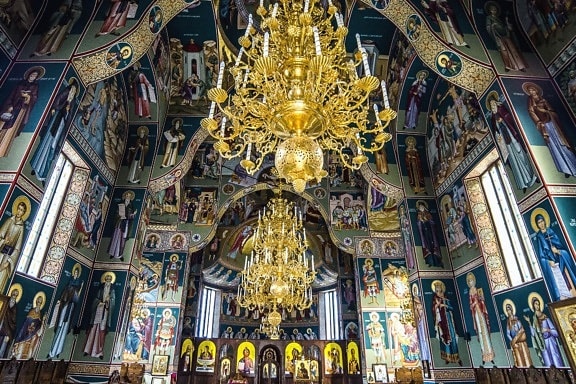What are the Orthodox Churches? This inquiry invites a delightful exploration into the world of ancient Christian traditions, layered with rich theological implications and historical significance. One might wonder, how do these traditions manifest in contemporary faith practices, and what challenges do they pose to modern believers? As we traverse this complex terrain, we shall uncover the essence of the Orthodox Churches and their contributions to the tapestry of Christian faith.
The term “Orthodox” derives from the Greek words “orthos,” meaning correct, and “doxa,” meaning belief or glory. Thus, the Orthodox Churches maintain a self-declared status of upholding the true faith as handed down from the apostles. This is not merely an assertion of correctness; it signifies a profound commitment to tradition, liturgy, and community that has evolved over centuries. These churches trace their lineage back to the early Christian community, particularly in the Eastern Mediterranean region, before the Great Schism of 1054 fractured Christianity into Eastern and Western branches.
Orthodox Christianity encompasses a broad spectrum of national and cultural expressions, including the Greek Orthodox, Russian Orthodox, Serbian Orthodox, and other national churches. While they exhibit unique attributes, these denominations are unified in essential doctrines and sacramental practices. The Nicene Creed serves as a foundational theological declaration, affirming beliefs in the Trinity and the divinity of Christ. This shared creed fosters an identity that bridges diverse cultural practices, from the intricate iconography of the Byzantine tradition to the exuberant folk customs embedded in Slavic practices.
The sacraments, or sacred mysteries, form the bedrock of Orthodox liturgical life. The Eucharist, in particular, is at the center of Orthodox worship. This sacrament is perceived not as a symbolic act but as a genuine participation in the divine mystery of Christ’s body and blood. The priest, acting in the person of Christ, offers the gifts upon the altar, inviting the faithful into communion with God. This understanding bestows great reverence upon the liturgy, which is often celebrated with splendid rituals, music, and art, drawing believers into a transcendent experience that harkens back to the early Christian gatherings.
Moreover, the Orthodox Churches place significant emphasis on the continuity of tradition. Unlike many Western denominations that may adapt theology to contemporary contexts, the Orthodox Churches are steadfast in their adherence to the teachings and practices of the early Church Fathers. This focus fosters an enduring connection with Christianity’s foundational narratives, showcasing an unbroken chain that stretches back to the apostolic era. The veneration of saints and the use of icons are vital components of this tradition that underscore the community’s collective memory and shared faith.
Icons, often seen as windows to the divine, play a pivotal role in Orthodox worship and personal devotion. These sacred images are not mere decorations; they are theological statements that communicate profound spiritual truth. The creation of an icon is a meticulous process requiring prayer and adherence to strict conventions, ensuring that the finished work reflects the celestial beauty of the saints it represents. In this way, icons serve both as a meditative focus for the faithful and as a means of connecting the material world with the spiritual realm, inviting contemplation and reverence.
Furthermore, the liturgical calendar unfolds a rich tapestry of feasts and fasts, exemplifying the cyclical nature of the Orthodox spiritual journey. Major feasts such as Pascha (Easter) and Christmas are celebrated with fervor, often involving elaborate rituals that reinforce community bonds. The seasons of fasting, particularly Great Lent, are seen not merely as periods of abstinence but as opportunities for spiritual renewal and deeper communion with God. During these times, believers engage in self-examination, prayer, and acts of charity, all aimed at spiritual transformation and growth.
In examining the ethos of the Orthodox Churches, one encounters a unique challenge inherent in the interplay between tradition and modernity. How does one remain rooted in ancient practices while addressing contemporary issues such as secularism, globalization, and individualism, which often dilute collective faith? The Orthodox response involves a reaffirmation of the importance of community and the Church as the Body of Christ. Unlike a mere gathering of individuals, the Church embodies a living organism where believers contribute to a larger narrative anchored in love and service.
This challenge extends to theological discourse, where Orthodox scholars engage with contemporary questions while remaining anchored in tradition. The dialogue is not about reformation but refinement. Can the ancient liturgies and teachings resonate in a world marked by rapid change? The answer lies in the timeless nature of Orthodox spirituality, which invites all to embark on a shared journey toward the divine. It is this rich interplay of tradition, community, and spirituality that endows the Orthodox Churches with a distinctive character within the broader Christian narrative.
In conclusion, the Orthodox Churches represent a bastion of ancient Christian traditions, unearthing an array of practices and beliefs that have stood the test of time. They offer believers a profound sense of identity grounded in Apostolic succession and an unwavering commitment to the sacred mysteries. As the world continues to transform, the challenge remains for the Orthodox community to maintain its cherished heritage while embracing the necessity for dialogue in an evolving landscape. With an eye toward the past and a heart open to the future, the Orthodox Churches illuminate the eternal call to unity in Christ.



